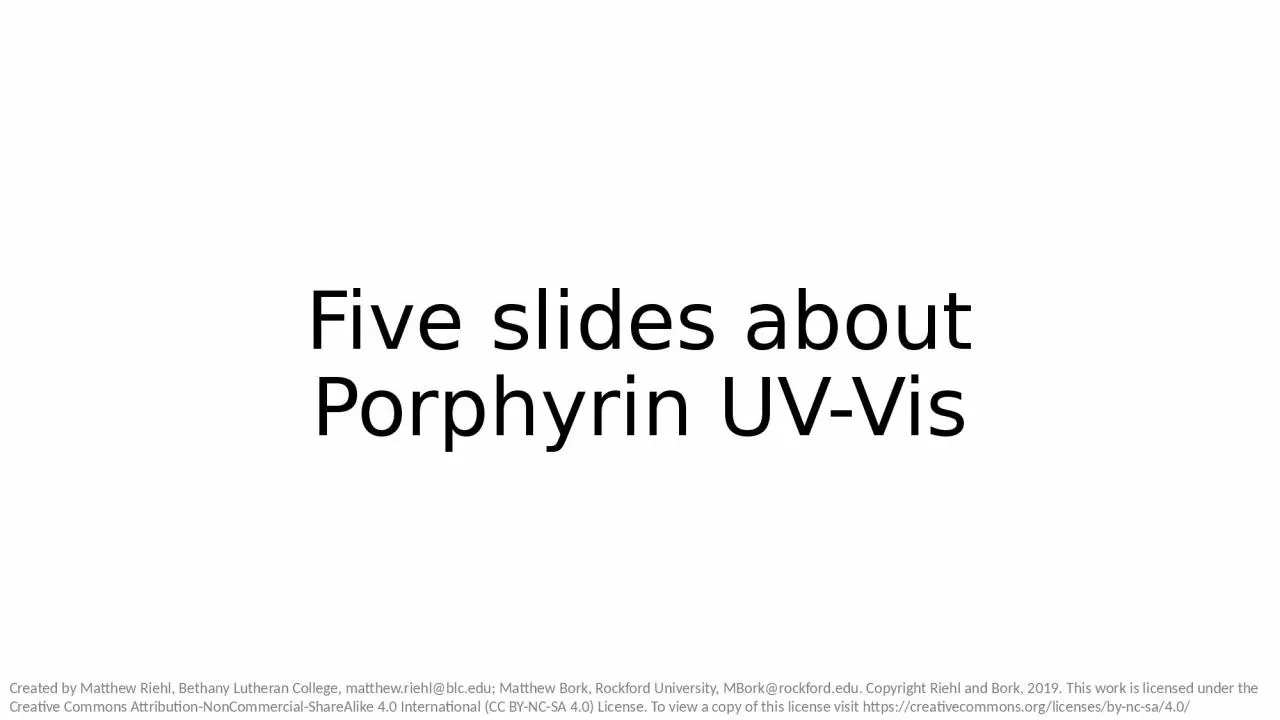

Created by Matthew Riehl Bethany Lutheran College matthewriehlblcedu Matthew Bork Rockford University MBorkrockfordedu Copyright Riehl and Bork 2019 This work is licensed under the Creative Commons Attribution ID: 1039555
Download Presentation The PPT/PDF document "Five slides about Porphyrin UV-Vis" is the property of its rightful owner. Permission is granted to download and print the materials on this web site for personal, non-commercial use only, and to display it on your personal computer provided you do not modify the materials and that you retain all copyright notices contained in the materials. By downloading content from our website, you accept the terms of this agreement.
1. Five slides about Porphyrin UV-VisCreated by Matthew Riehl, Bethany Lutheran College, matthew.riehl@blc.edu; Matthew Bork, Rockford University, MBork@rockford.edu. Copyright Riehl and Bork, 2019. This work is licensed under the Creative Commons Attribution-NonCommercial-ShareAlike 4.0 International (CC BY-NC-SA 4.0) License. To view a copy of this license visit https://creativecommons.org/licenses/by-nc-sa/4.0/
2. Learning OutcomesThe student will… understand the porphyrin core structure, the numbering, and naming schemes of porphyrinsdemonstrate that the porphyrin is aromatic, obeying the Hückel 4n+2 rule where n=4.recognize the key features of the porphyrin UV-Vis spectra: the Soret Band and the Q-bands qualitatively describe Gouterman’s four-orbital model to explain the spectra.
3. Porphyrin Structure and NumberingThe 20 carbon atoms that form the outer ring are numbered clockwise 1-20 as shown. The nitrogen atoms are 21-24.Eight b positions are on the pyrrolic rings (2, 3, 7, 8, 12, 13, 17, 18).Four meso positions are on the methine bridges (5, 10, 15, 20).
4. Porphyrin Aromaticity & MOsRed bonds show one path for 18 electron Hückel aromaticity.Other paths exist – none of the double bonds are simple localized bonds.Molecular orbitals are consistent with a p-delocalized ring system.Nine bonding MOs are filled by the 18 delocalized electrons.In a simple model, both the HOMO and LUMO are degenerate pairs of orbitals.
5. Porphyrin SpectraTypical UV-Vis for three tetra-phenylporphyrins: H2TPP, ZnTPP, and MgTPPSoret band or B-band Named for J.-L. Soret who first described it in 1883.1Occurs in the near-UV, exact position depends on nature of porphyrinQ-bandsMuch smaller, in the visible region.Symmetrical metalloporphyrins typically have two bands,H2TPP has four bands due to the reduced symmetry from interior hydrogens. SoretQ-bands
6. Gouterman’s four orbital modelBeginning in the late 1950’s Martin Gouterman developed a model to explain the absorption spectra of porphyrins.2-5 This model focused on four molecular orbitals: the two highest occupied molecular orbitals and the two lowest unoccupied molecular orbitals. The model predicts four transitions between the HOMOs and LUMOs.The number of bands observed depends on the degeneracy of the LUMOs but the intensity is more difficult to rationalize.The Q-bands are much weaker in intensity, but are easily resolved.
7. GoutermanIn a metalloporphyrin with D4h symmetry,The four orbitals in Gouterman’s model are the HOMOs (a1u, a2u) and LUMOs (egx, egy)The HOMOs are not degenerate, with the a1u being at a lower energy.a1u®eg transitions give rise to the Soret bandsa2u®eg transitions give rise to Q bands
8. GoutermanThe number of Q-bands is equal to twice the number of allowed transitions due to a vibrational component.The energy difference between two Q-bands is approximately equal to the energy of a vibrational transition.The lower energy Q-band is a 0-0 transition – from a ground vibrational state to a ground vibrational stateThe higher energy Q-band is a 0-1 transition – from a ground vibrational state to the first excited vibrational state.Replacing a metal with two protons to obtain H2TPP reduces the symmetry from D4h to D2h. This removes the degeneracy of the LUMO eg orbitals and doubles the number of observed transitions.The Soret in H2TPP can be resolved into two peaks at low temperature, but typically is observed as a single peak.
9. GoutermanAll of the HOMO-LUMO transitions are allowed, and a simple model predicts they should have nearly equal intensity.However, orbital mixing occurs and leads to the drastic differences in intensities.In the a2u®eg transitions, the transition dipoles nearly cancel leading to the weak Q-absorptions observed.In the a1u®eg transitions, the transition dipoles reinforce, leading to the strong absorbance seen in the Soret band.
10. Questions:What are the Soret and Q bands?Why is the Soret large and Q small?Why is there one Soret and four Q bands (H2TPP) or two Q bands (MTPP)?Electronic transitions between the HOMO and LUMO are responsible for the absorption spectra – What are the HOMO and LUMO for porphyrins?The transitions between HOMO and LUMO are allowed – why are the Soret and Q-bands so different?
11. ReferencesSoret, J.-L., Comptes Rendus, 1883, 97, 1269–1270. Gouterman, M., J. Chem. Phys., 1959, 30, 1139-1161.Gouterman, M., J. Mol. Spectroscopy, 1961, 6, 138-163.Gouterman, M., Wagnière, G. H., J. Mol. Spectroscopy, 1963, 11, 108-127.Weiss, C., Kobayashi, H., Gouterman, M., J. Mol. Spectroscopy, 1965, 16, 415-450.